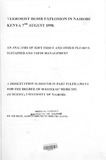| dc.contributor.author | Adung'o, I | |
| dc.date.accessioned | 2013-05-23T12:20:38Z | |
| dc.date.available | 2013-05-23T12:20:38Z | |
| dc.date.issued | 2002 | |
| dc.identifier.citation | Master of Medicine in Surgery, University of Nairobi, 2002 | en |
| dc.identifier.uri | http://erepository.uonbi.ac.ke:8080/xmlui/handle/123456789/24888 | |
| dc.description.abstract | Terrorist bombings are ugly acts of the modern world that are usually politically
motivated. The explosives used range from home made devices to conventional
explosives such as grenades and bombs, with materials such as nails, radioactive and
toxic substances added to the explosive devices sometimes. On 7th August 1998, Nairobi
was the victim of a terrorist attack targeted at the American embassy. The dual explosion
injured non-suspecting civilians as well as rescuers. This retrospective study has analyzed
the effects and injuries due to this bombing. All patients treated at Kenyatta Hospital for
blast related injuries that met the inclusion and exclusion criteria were included in the
study. Data was collected in a questionnaire and entered into Microsoft excel and SPSS
data sheets for analysis. An estimated 5000 people were injured in the bombing, while
213 died at the site. 1471 were treated at Kenyatta National hospital for bomb blast
related injuries. 54.5% were male, 71.6% were between 20 and 40 years old.
Flying debris and shrapnel caused most of the injuries. The injured sustained mainly soft
tissue injuries that were treated on an out patient basis. The regional distribution of soft
tissue injury suggests the protective role of clothing and headgear. Scars; keloids and
hypertrophic scars, were the commonest complication following these injuries. Scar
management formed the bulk of work during the reconstruction period. Patients were
admitted mainly for injuries that required surgery in main theatre, head injury was the
main cause of in-patient hospital deaths. Though skeletal injuries were uncommon, most
of the fractures seen involved long bones.
Effective management of a disaster of this magnitude requires inter-departmental
cooperation. Triage should start at the site of accident, and the casualties rapidly
transported to medical care institutions. In hospitals, a disaster management team, whose
responsibility is to rapidly mobilize human and material resources, is essential | en |
| dc.language.iso | en | en |
| dc.publisher | University of Nairobi. | en |
| dc.title | Terrorist bomb explosion in Nairobi Kenya 7th August 1998. an analysis of soft tissue and other injuries sustained and their management | en |
| dc.type | Thesis | en |
| dc.description.department | a
Department of Psychiatry, University of Nairobi, ; bDepartment of Mental Health, School of Medicine,
Moi University, Eldoret, Kenya | |
| local.publisher | Faculty of Medicine | en |

